A variety suitable for cultivation even in the northern regions of the country - watermelon “Sugar Baby”
Watermelon is a heat-loving crop that produces large, sweet fruits whose taste is associated with summer and relaxation. Despite the popularity of this berry, many gardeners have never tried to grow it, believing that it is too labor-intensive and expensive. Also, most people have the opinion that it is possible to grow this representative of melons only in the south.
Actually this is not true. Thanks to modern breeding, varieties have appeared on sale that are characterized by increased resistance to adverse environmental factors. These include the watermelon Sugar Baby.
General description of the watermelon variety
Sugar baby is an old and time-tested variety of watermelon.. It was bred more than 60 years ago by foreign breeders. His original name is Sugar Baby.
It was added to the Russian state register only in 2008. The variety is produced by many domestic seed production companies.
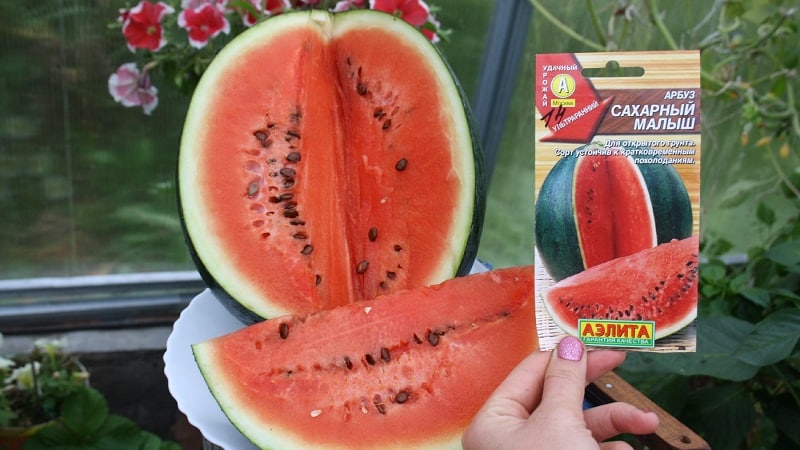
Distinctive features
The main distinguishing feature of the Sugar Baby is its miniature fruits.. The weight of each of them does not exceed 4 kg. This portion size makes them convenient for the consumer.
The taste of the variety is different from its larger counterparts. The fruit pulp is juicy, coarse-grained and very sweet. Watermelons have a dark green rind.
Sugar baby is cold-resistant. Unlike many other watermelons, it is suitable for growing in open ground not only in the southern, but also in the central regions.In cities with cool climates it is cultivated in greenhouses.
Immunity to diseases of melons and melons – another positive trait of a Sugar Baby. It does not require additional treatment with chemicals, which makes it possible to grow environmentally friendly fruits.
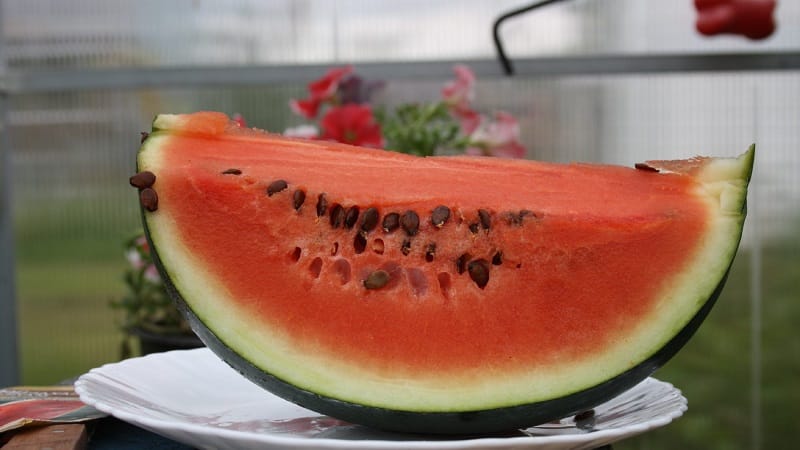
Beneficial features
Consumers like watermelon fruits not only for their sweet, refreshing taste, but also for their beneficial properties. Among them the most pronounced:
- Choleretic effect. Watermelon does not allow bile to stagnate. This property has a positive effect on skin color and liver function.
- Diuretic effect. Kidney function is normalized and blood pressure is reduced.
- Removing harmful substances from the body, including cholesterol. Thanks to this, the cardiovascular system is strengthened.
- Normalization of the functioning of the gastrointestinal tract. This property is due to the high fiber content of the fruit.
- Watermelon prevents vitamin deficiency and improves the condition of the body. Watermelon contains almost the entire spectrum of B vitamins, as well as vitamins A, E, PP, H, C.
note! It is believed that eating watermelons helps to cope with small stones and sand in the urinary system and liver.
Watermelon is a dietary product. There are only 25 kcal per 100 g of pulp.
Main characteristics
The characteristics of the Sugar Baby make it possible to grow it in the central and northern regions. After all, it is distinguished not only by its cold resistance, but also by its early ripening.
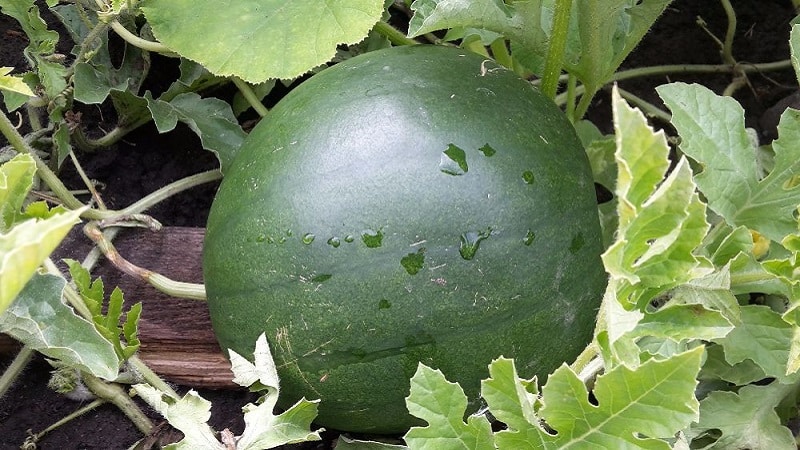
Description of Sugar Baby:
| Parameter | Index |
| Ground part | Climbing. The central shoot does not grow longer than 2 m. The side shoots are shorter. The leaves are medium sized with strong dissection. Color grey-green. |
| Fruit | Small sizes.The weight of each of them varies between 1-4 kg. Occasionally there are specimens weighing up to 6 kg. The shape is round, leveled. The crust is strong but thin. The color is dark green. There are darker, thinner stripes throughout the area. The pulp is dark red, grainy, tender and juicy. The taste is rich and sweet. The aroma is rich watermelon and honey. The seeds are small, covered with a dark brown shell with a characteristic pattern. Suitable for sowing. |
| Productivity | Average. From 1 sq. m get up to 10 kg of harvest. |
| Ripening time | Early ripening variety. 80-85 days after seed germination, the first harvest is obtained. |
| Growing conditions | Cold-resistant variety. In the southern and central regions it is usually cultivated in open ground. In the northern regions, cultivation in a greenhouse is possible. |
| Transportability | High. The fruits do not deteriorate during transportation. They are stored for more than a month. |
| Resistance to infections | Has immunity to major diseases of melons and melons. |
Note! Manufacturers claim that Sugar Baby is highly immune to all melon and melon diseases. However, there are reviews from gardeners reporting cases of root rot of this variety. This problem occurs when the soil is waterlogged.
How to grow this variety yourself
Sugar baby is one of the easiest watermelon varieties to care for.. Even a beginner can cope with its cultivation, provided that the basic rules of agricultural technology are followed. An important stage in growing watermelons is preparing the beds. They do this in the fall.
Important! Unlike many other crops, watermelon does not survive on peat soils. Therefore, this component does not need to be added to the soil.
Make sure that the area of the garden where you plan to plant the watermelon is in the previous 3 years it was not used for growing melons. Such plants increase the chances of plantings becoming infected with infections and pests. You should not grow pumpkin, zucchini and melon in neighboring beds.
The best predecessors for watermelons are considered: onions, carrots, cabbage, any greens, garlic, nightshade crops. The best option is radish (the likelihood that plants will be affected by spider mites in the beds where this crop previously grew is minimal).
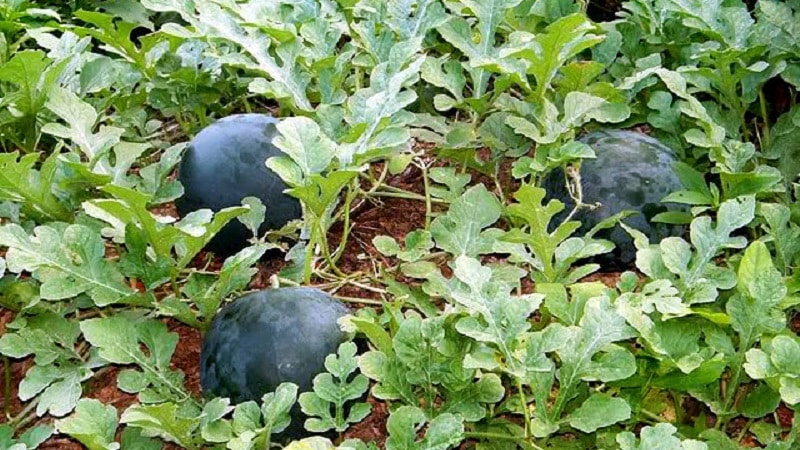
In autumn, the beds are dug to a depth of 20 cm and cleaned of plant residues. The soil is mixed with manure at the rate of 6-8 kg per 1 sq. m.
Advice! A good effect is achieved by planting rye, sweet corn or any perennial herbs in beds in winter. In the spring, a month before planting the watermelon, young plants are dug up and mixed with soil.
In spring, the beds are leveled with a rake and cleared of weeds.. 15 g of urea per 1 square meter is added to the soil. m. Then the soil is watered with hot copper sulfate. If the acidity of the soil is increased, then ash, dry lime or eggshells are added to it. Sand will help make the soil looser.
Holes are dug in rows in a checkerboard pattern. A distance of 1 m is maintained between them. It is recommended to pour ash into the bottom of the recesses. It will also be useful to pour in 1 liter of chicken manure diluted 1:10.
Other varieties of watermelons:
Early ripe hybrid watermelon “Top Gun”
Landing
Watermelon is grown in seedlings and without seedlings. The second option is only suitable for the southern regions. In this case, the harvest will be ready for harvest a month later.
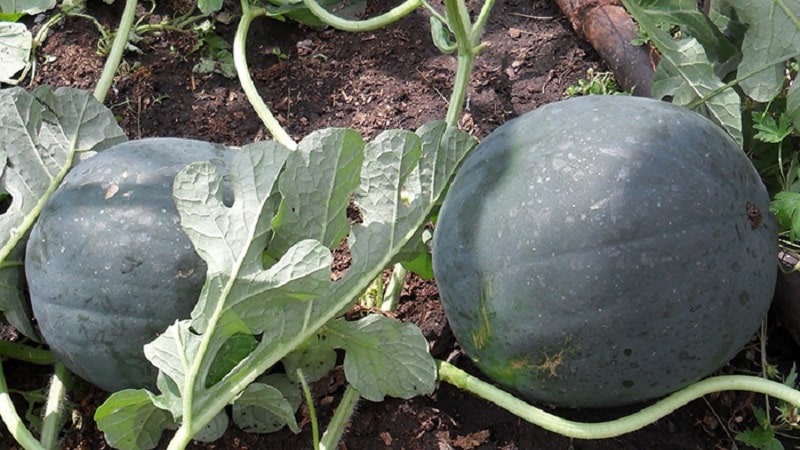
So that all the seeds germinate and the plants turn out strong and hardy, it is important to properly prepare planting material for sowing:
- Select seeds that are dense, without damage or mold stains. They are soaked in salted (1 tsp per glass) water. After half an hour, the floating specimens are collected and thrown away, and those that have sunk to the bottom are used for further planting.
- The seeds are soaked for half an hour in a light pink solution of potassium permanganate or for 15 minutes. in hydrogen peroxide. The planting material is washed again.
- For a day, the seeds are soaked in water at a temperature of 40-50 °C. To prevent the liquid from cooling down, place the container on the battery.
After this, they immediately begin sowing seeds or germinating planting material.. In the second case, it is wrapped in a cloth moistened with warm water and placed in one container, which is covered with film and put in a warm place until the seeds germinate.
Seed method
The seedless method is suitable for the southern regions. In this case, planting material is sown directly into open ground. Sowing seeds is possible only when the soil at a depth of 15 cm warms up to a temperature of 15 °C. In cities with a southern climate this occurs in early May.
Before sowing the seeds, the holes are prepared. A layer of humus or rotted manure is poured onto the bottom. Then the hole is covered with garden soil. The manure bed will provide the seeds with the necessary nutrients to germinate.
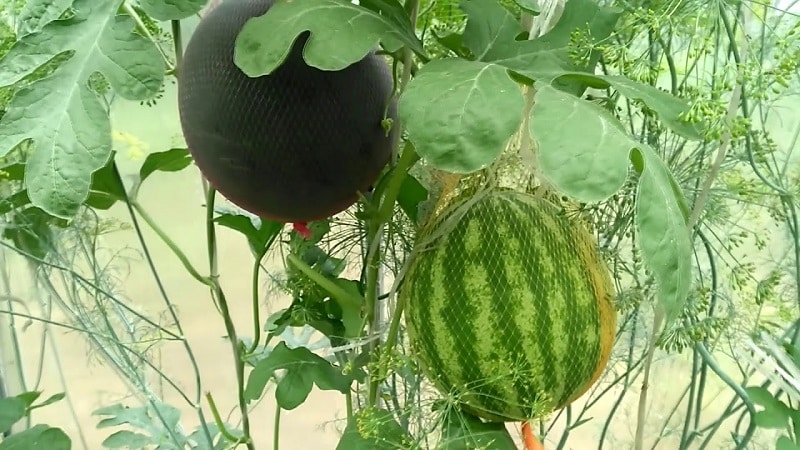
2 seeds are sown in each hole. They should be located in different parts of the recess. The seeds are buried 4-5 cm.
The sifted seeds are watered with warm water. Then the beds are covered with film. It is opened slightly for ventilation for 30 minutes. daily during warm weather. When the first shoots appear, the duration of ventilation is increased. After a week, the film is completely removed from the crops.
If both seeds sprouted in the hole, then the weaker stem is pinched. This is done at the stage of formation of the second leaf.
Seedling method
The seedling method is considered the most reliable. In this case, already grown plants are planted in the ground. This ensures an earlier harvest. In cities with temperate and cold climates, this is the only way to grow watermelons.
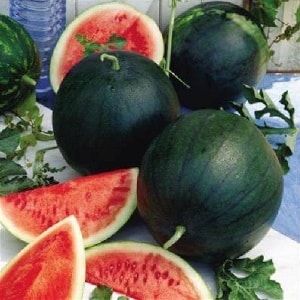 Seedlings begin to be grown in the second half of April. A month later they are taken to a permanent location.
Seedlings begin to be grown in the second half of April. A month later they are taken to a permanent location.
Prepare soil for seedlings in advance. To do this, mix equal parts of humus and garden soil. Add half a portion of washed sand or sawdust to the resulting mixture. Add 2 tbsp to every kilogram of soil. l. ash. The soil is calcined in the oven or watered with a dark pink solution of potassium permanganate. Drainage is disinfected (shell stone, broken ceramics or expanded clay) in the same way.
Watermelon seedlings immediately grown in individual pots. It is better to use peat containers, but plastic cassettes and cups will also work.
A 1-2 cm layer of drainage is poured onto the bottom of the container. The rest of the volume is filled with soil so that 5 cm is left free to the edge of the container. Place 1 seed in each container. They are sprinkled with a 3 cm layer of soil. The soil is not compacted. The soil is carefully watered with warm water. It is important to ensure that the planting material is not exposed. Containers with seeds are placed in a warm (25-27 ° C) place. After the first shoots appear, the seedlings are grown at room temperature.
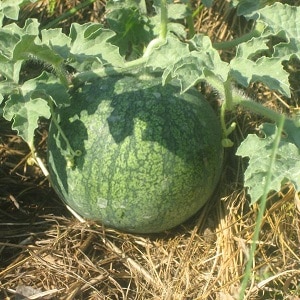 Water the seedlings as the soil dries out. Use only settled water at room temperature.
Water the seedlings as the soil dries out. Use only settled water at room temperature.
10 days after seed germination, seedlings are fed. They use such products as “Mortar”, “Sotka”, etc.The second feeding with the same means is done after another 10 days.
In the second half of May, Sugar Baby seedlings are planted in a permanent place. 1 tbsp is poured into each hole. l. ash. Then the seedlings are planted there along with a lump of earth. In this case, the earthen lump from the pot should rise 1 cm above the level of the bed. This will prevent rotting of the root collar of the plants. Each hole is watered with 1 liter of water. For the first 2 weeks, the seedlings are covered with film at night.
Read also:
Do picked watermelons ripen at home?
How to understand that a watermelon has gone bad and what to do if this happens
Caring for a Sugar Baby
Sugar Baby's whip doesn't need to be tied up.. They are often left lying on the ground. Some gardeners prefer to attach them to trellises.
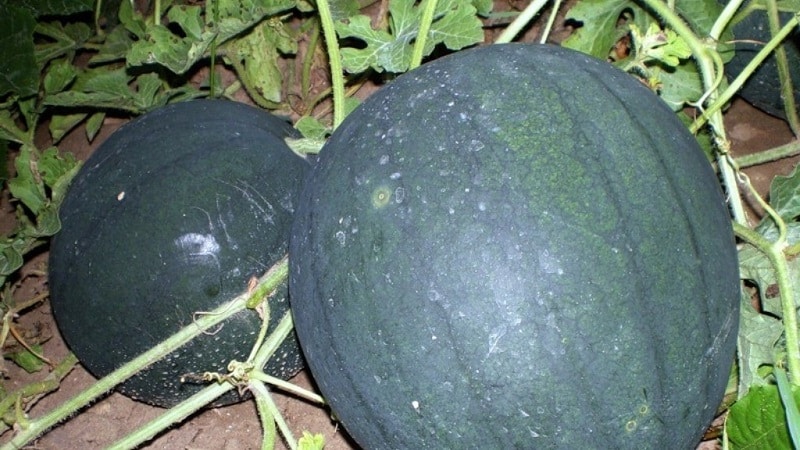
Watermelons are watered infrequently (1-2 times a week), but generously. They do this in the evening. For 1 sq. m of planting, use 30 liters of warm, settled water. After each watering, the soil is loosened. The beds are cleared of weeds.
Watermelon is fed 3-4 times per season. The following drugs are used for this:
- After the formation of the 3rd leaf, the first nitrogen fertilizing is applied. The second time this product is used is after 2 weeks.
- During the period of ovary formation and fruit ripening, fertilizers are applied 2 more times. Use complex fertilizers containing phosphorus and potassium.
Features of cultivation and possible difficulties
When growing watermelons, you need to consider several nuances, which will help you avoid many problems and get a rich harvest. Here are some of them:
- During the period of fruit ripening, watering is stopped. This will prevent them from cracking.
- As the lashes grow, they are sprinkled near the base, which stimulates the formation of a stronger root system.
- In case of precipitation and high humidity, cardboard or plywood substrates are placed under the watermelons. They will prevent fruit rotting.
- If the plants were attached to a trellis, then the fruits hanging on the vines are strengthened with a net so that the stem does not break under their weight.
- When growing watermelons, gardeners try to avoid the use of chemicals. Otherwise, harmful substances will accumulate in their pulp.
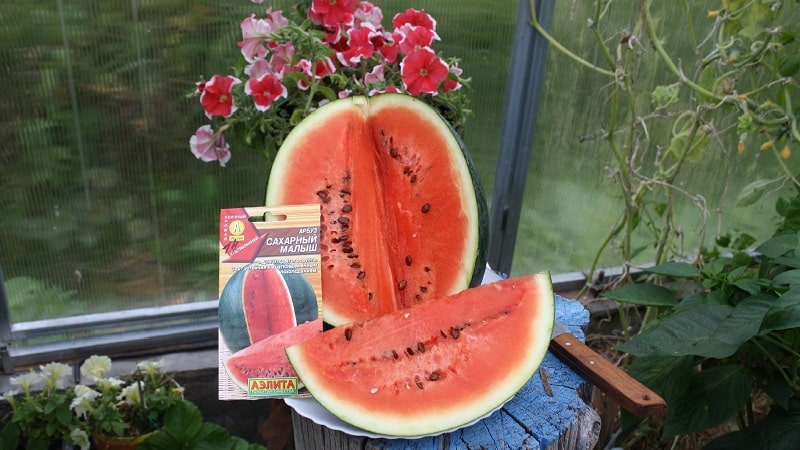
Diseases and pests
Watermelon Sugar Baby has strong immunity to most diseases melon crops. Some gardeners say that the plant may become infected with root rot. If such a problem arises, reduce the intensity of watering, treat the soil with a weak solution of potassium permanganate and sprinkle the vines with earth in additional areas. This will promote the formation of new roots and prevent the death of asthenia.
Equally important is compliance with the rules of care and crop rotation.. Soil, garden tools and planting material must be disinfected.
If the plants are attacked by pests, they are sprayed with a decoction of wormwood or a solution prepared from a bar of soap and a bucket of water. Gardeners try not to use chemicals when growing this crop.
Harvesting and application
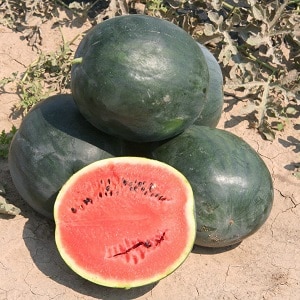 Sugar Baby fruits are harvested in July. The following signs indicate the ripeness of the crop:
Sugar Baby fruits are harvested in July. The following signs indicate the ripeness of the crop:
- the stalk becomes dry and acquires a brownish tint;
- when tapping a berry, a dull sound is heard;
- the greenery begins to wilt.
The Sugar Baby harvest is stored in a dry, dark place at a temperature of +2…+4 °C. There should be no damage or dents on the fruits.
Watermelons are mainly consumed fresh.. Small fruits are fermented and used as a side dish for meat dishes.
Advantages and disadvantages of the variety
Benefits of a Sugar Baby:
- cold resistance;
- ease of care:
- keeping quality and transportability;
- the possibility of using seeds from your own harvest;
- immunity to melon and melon diseases;
- rich sweet taste of the fruit.
Some gardeners consider small fruit to be a disadvantage of this variety.. Other gardeners like the compact nature of Sugar Baby fruits.
Reviews
Reviews of Sugar Baby are mostly positive.. Some gardeners question its resistance to root rot.
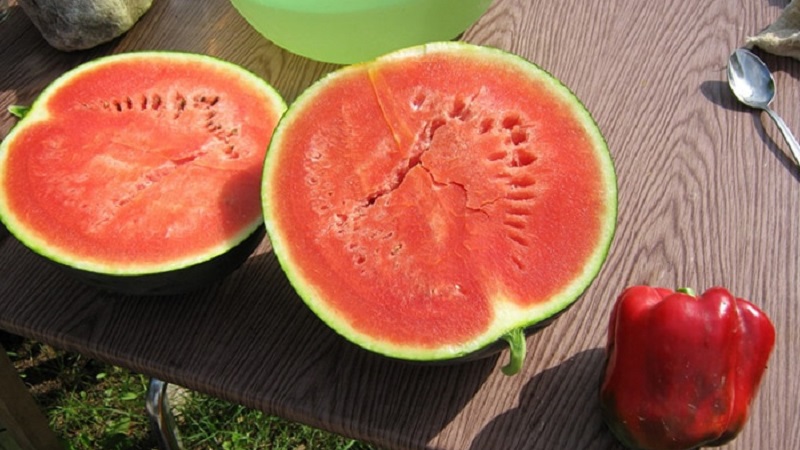
Roman, St. Petersburg: “I’ve been growing Sugar Baby for about 6 years now. This is one of the few varieties that can grow in open ground in our region. During the rainy summer I suffered from root rot a couple of times, but I am not susceptible to other infections. In such years I grow it under film. The fruits are small (1-3 kg), but very tasty. It’s convenient that a cut watermelon is eaten immediately and does not sit in the refrigerator for a long time.”.
Valentina, Krasnodar: “I liked the Sugar Baby variety. Easy to care for, never got sick. I consider small fruits an advantage. We not only eat them fresh, but also pickle them for the winter. It makes a very tasty snack".
Conclusion
Watermelon Sugar Baby is one of the few varieties that can grow in temperate regions in open ground. It is characterized by increased cold resistance and high immunity to diseases of melons and melons. Even novice gardeners can cope with its agricultural technology.
The fruits of this watermelon, although small in size, have a rich sweet taste and honey aroma. They are delicious both fresh and pickled.